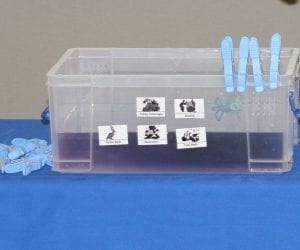Few things symbolize our poor stewardship of the earth quite as much as the Pacific Garbage Gyre, or as it is better known, the Great Pacific Garbage Patch.
What is the Pacific Garbage Gyre?
The Pacific Garbage Gyre is a collection of three million tons of trash floating in the central part of the North Pacific Ocean. The term “gyre” is important because the trash does not just float atop the water but extends at least 100 feet below the surface. And, while the gyre contains substantial amounts of garbage, it is too scattered to be easily spotted from a ship or satellite, and cannot be landed on, like an island. Most of the plastic consists of small pieces floating slightly below the surface of the ocean. Over the last 60 years, since the invention of plastics, the currents of the North Pacific have pushed the debris from ships, rivers, and coastal areas into this area of up to 5.8 million square miles (though due to the shifting patterns created by wind and currents, the low density of the garbage, and the difficulty of accessing the region, exact data is limited). The gyre itself was only discovered by yachter Charles Moore in 1997.
How Does the Pacific Garbage Gyre Impact Ocean Health?
Because the gyre is located in a specific region of the Pacific that remains fairly stationary, the plastic (which makes up 90% of the oceans’ garbage, due to its slow rate of decay) and other materials stay within the region, instead of being washed up on the shore or carried into other parts of the oceans. This region is also an important home for various animal and plankton species, many of which are negatively affected by the garbage buildup. Major seabird breeding grounds in the Midway Islands have suffered from the birds ingesting plastic or getting caught in it, and sea creatures such as turtles and dolphins have suffered similarly. Pollutants such as BPA released by the decomposing plastic have ramifications throughout the food chain, including in the fish humans eat. Hawaii, the closest land to the gyre, often has beaches covered with trash after storms. And no research has yet been done to examine the seabed below the gyre, to observe the effects of sinking plastic.
Can We “Clean Up” the Pacific Garbage Gyre?
Unfortunately, the cost of studying and cleaning the Great Pacific Garbage Gyre, the debate over which nation has responsibility for it, and its lack of immediate impacts on most of the world, mean that little has been done to eliminate it. The gyre keeps growing as more litter reaches the Pacific Ocean, having increased 100 times over in the past 40 years. Still, enacting more stringent restrictions on waste disposal near the oceans, recycling or replacing plastic in daily use, and realizing the consequences of a small act of littering can help to prevent the continued growth of this blot on our oceans.



